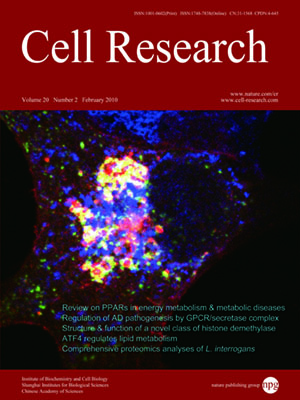
Volume 20, No 2, Feb 2010
ISSN: 1001-0602
EISSN: 1748-7838 2018
impact factor 17.848*
(Clarivate Analytics, 2019)
Volume 20 Issue 2, February 2010: 185-196
ORIGINAL ARTICLES
Small ubiquitin-related modifier paralogs are indispensable but functionally redundant during early development of zebrafish
Hao Yuan1,2, Jun Zhou2, Min Deng3, Xi Liu2, Morgane Le Bras4, Hugues de The2,4, Sai Juan Chen1,2, Zhu Chen1,2, Ting Xi Liu3 and Jun Zhu2
1State Key Laboratory of Medical Genomics, Institute of Health Science, Shanghai Institutes for Biological Sciences and Graduate School, Chinese Academy of Sciences and Shanghai Jiao Tong University School of Medicine, 225 Chong Qing South Road, Shanghai 200025, China
2CNRS LIA, Shanghai Institute of Hematology, Rui Jin Hospital, 197 Rui Jin Road II, Shanghai 200025, China
3Laboratory of Development and Diseases, Institute of Health Science, Shanghai Institutes for Biological Sciences and Graduate School, Chinese Academy of Sciences and Shanghai Jiao Tong University School of Medicine, 225 Chong Qing South Road, Shanghai 200025, China
4CNRS UMR 7151, Hopital Saint Louis, 1, Avenue, C Vellefaux, 75475 Paris Cedex 10, France
Correspondence: Jun Zhu, Ting Xi Liu, Zhu Chen(jzhu1966@yahoo.com.cn; txliu@sibs.ac.cn; zchen@stn.sh.cn)
The Small ubiquitin-related modifier (SUMO) conjugation to a variety of proteins regulates diverse cellular processes, including transcription, cell cycle regulation and maintenance of genome integrity. To investigate in vivo biological function of SUMO paralogs, we inactivated them in the early development of zebrafish. While zebrafish embryos deficient for all three SUMO paralogs, as Ubc9-deficient ones, displayed severe defects, loss of individual SUMO paralog was compatible with a normal development. SUMO-deficient embryos can be rescued by a single human or zebrafish SUMO. While key structural basic lysine residues and N-terminal unstructured stretch of SUMO are critical for in vivo rescue, the consensus K11 sumoylation site of SUMO2 is dispensable, implying that chain formation on this potential site is unessential for normal development. Inactivation of all three SUMOs triggered p53-dependent apoptosis and further inactivation of p53 restored normal zebrafish development. Interestingly, we also demonstrate that the dominant negative truncated form of p53, Δ113p53, significantly blunts SUMO depletion-induced p53 activity in vivo. Taken together, our results suggest that SUMO paralogs are indispensable, but redundant, in the early development of zebrafish.
Cell Research (2010) 20:185-196. doi: 10.1038/cr.2009.101; published online 25 August 2009
FULL TEXT | PDF
Browse 2497


